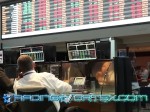What is Pips in Forex Trading ?
The actual value of a pip depends on your account capital. For example:
- In a standard account of $10,000, each pip is equivalent to one unit of the currency. So, if your account is denominated in USD, as in EUR/USD, then one pip is worth about $1 and for every one pip move, you will see $1 of profit or loss on your account.
In a micro account, on the other hand, one pip is equivalent to 1/10th of that of a standard account. So, each pip is worth about $0.10.
So, for example:
- If EUR/USD is currently trading at 1.3123 and then the exchange rate changes to 1.3128, we say the pair rose by 5 pips. If EUR/USD depreciated from 1.3123 to 1.3122, then the pair dropped by 1 pip, which is 0.0001 of a unit.
- If the currency pair of the EUR/USD has the bid/ask rate of 1.3123/1.3127, then we say there is a four pip spread . In the case of currency pairs that involve Japanese yen, say, USD/JPY 115.14/115.17, we say this quote has a three pip spread between the buy and sell prices.
How to Calculate the Value of a Pip?
The actual value of a pip varies depending on the size of your trade. For example:
- If your trade is a Micro lot of 1k, you calculate the value of a pip based on 1,000.
- If you want the value of a pip for a standard lot, you start with 10,000. You then multiply your trade size by one pip for the pair that you are trading.
- To calculate the value of a pip for one 10k lot of EUR/USD, you start with 10,000. Multiply 10,000 by .0001 gives you a value of 1.
- That will be valued in the counter currency (second currency) of the pair you are trading.
- In this example, we are trading EUR/USD, so USD is the counter currency of this pair and one pip is worth 1 USD dollar for one 10k lot of EUR/USD.
- Therefore, if your account is based in US Dollars, then you will see $1 of profit or loss on your account for every 1 pip move that EUR/USD makes.
- However, if your account is based in British Pounds (GBP), you need to convert that $1 USD into Pounds.
- To do this, divide by the current GBP/USD exchange rate.
- So, let’s say1 British Pound is being exchanged at 1.54, then 1 divided by 1.54 gives us 0.64935 Pounds. That tells us that if you have a British Pound based account, you will see 0.64935 Pounds of profit or loss for each 1 pip move on one 10k lot of EUR/USD.
- In all pairs involving Japanese Yen (JPY), a pip is the 1/100th place – two decimal points instead of four. So, a standard lot of one 10k lot trade for all pairs that involve JPY, a pip is .01.
For a pair of GBP/JPY, the value of one pip is calculated as follows.
- A pip is .01 because it is a JPY pair.
- 10,000 x .01 = 100 That “100” is in terms of the counter currency, so it is 100 Japanese Yen (JPY).
- Now you need to convert that 100 JPY to the denomination of your account: if you have a USD based account, then divide 100 JPY by the USD/JPY spot rate, which at the time of this writing is 78.4680.
- 100 / 78.4680 = 1.2744.
- Therefore, if you are trading GBP/JPY and your account is based in US Dollars, you will see $1.2744 USD profit or loss for every 1 pip move on one 10k lot of GBP/JPY.
This may all sound a bit complicated but if you do some practice calculations a couple of times, it will become easier to understand.
For more information on PIPS, check out PIPS Explained.
Long and Short:
A Long position means you buy, and a Short position means selling. An Open position refers to creating a new trade and a Close position means you close an open position.
Take another example: We assume that the value of the EUR/USD pair goes up by one tick and the quote changed from 1.3425 to 1.3426. Then, we say the size of movement is one pip.
The pip is typically how success of each transaction is measured rather than by the actual dollar amount. So, one pip gain in a $100 account is equal to one pip gain in a $10,000 account although the actual dollar gain differs considerably.
Lots:
In general, there are three lot sizes offered by forex brokers: standard lot, mini lot, and micro lot.
- A stander lot usually represents 100,000 units of the base currency.
- A mini lot usually represents 10,000 unit of the base currency.
- A micro lot is typically equal to 1,000 unit of the base currency.
- So, for example, if a trader is Long 5 Lots EURUSD and his account is a standard account, it means that the trader purchased 500,000 EUR in exchange for USD.
What is Spread in Forex ?
The Ask price is always higher than the Bid price but spreads are minimal for most actively traded pairs like EUR/USD, GBP/USD, and USD/JPY, and they are usually around 1-4 pips. Spreads for other currency pairs tend to be higher.


















 TradingVortex.com® 2019 © All Rights Reserved.
TradingVortex.com® 2019 © All Rights Reserved.